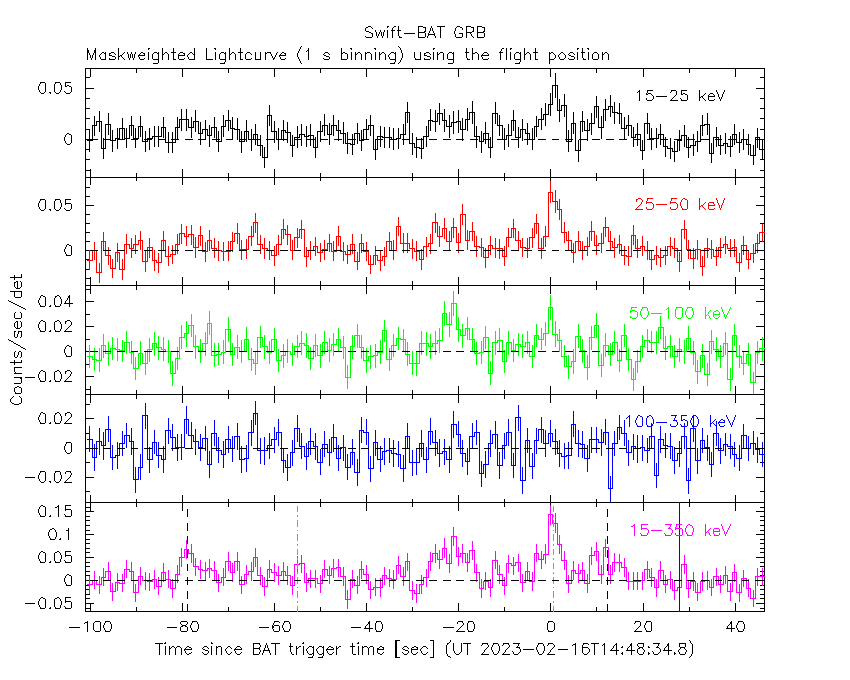
N.J. Klingler (GSFC/UMBC/CRESSTII), E. Ambrosi (INAF-IASFPA) and N. Klingler (GSFC/UMBC/CRESTII) for the Swift team
At 14:48:34 UT, the Swift Burst Alert Telescope (BAT) triggered and located GRB 230216A (trigger=1154815) (Klingler et al. GCN Circ. 33328). Swift slewed immediately to the burst. At the time of the trigger, the initial BAT position was 139° from the Sun (9.6 hours East) and 141° from the 19%-illuminated Moon. Table 1 contains the best reported positions from Swift, and the latest XRT position can be viewed at http://www.swift.ac.uk/xrt_positions.
Gendre et al. (GCN Circ. 33329) reported the position from Zadko for the optical afterglow of this GRB. Table 2 is a summary of GCN Circulars about this GRB from observatories other than Swift.
Standard analysis products for this burst are available at https://gcn.gsfc.nasa.gov/swift_gnd_ana.html.
As reported by Stamatikos et al. (GCN Circ. 33336),
the BAT ground-calculated position is
RA, Dec = 113.966, -7.993 deg which is
RA(J2000) = 0
The mask-weighted light curve (Figure 1) shows a trio of peaks at approximately T-80 s,
T-20 s and T+0 s, with some possible substructure and other, smaller
peaks.
The time-averaged spectrum from T-81.07 to T+16.40 s is best fit by a simple
power-law model.
The power law index of the time-averaged spectrum is
1.90 ± 0.23.
The fluence in the 15-150 keV band is 1.3 ± 0.2 x 1
The results of the batgrbproduct analysis are available at https://gcn.gsfc.nasa.gov/notices_s/1154815/BA/.
Analysis of the initial XRT data was reported by Ambrosi et al. (GCN Circ. 33335). We have analysed 23 ks of XRT data for GRB 230216A, from 84 s to 635.7 ks after the BAT trigger. The data comprise 8 s in Windowed Timing (WT) mode (taken while Swift was slewing), with the remainder in Photon Counting (PC) mode. The enhanced XRT position for this burst was given by Osborne et al. (GCN Circ. 33331).
The late-time light curve (Figure 2) (from T0+4.5 ks) can be modelled with a power-law decay with a decay index of α=1.83 (+0.13, -0.11).
A spectrum formed from the PC mode data can be fitted with an absorbed power-law with a photon spectral index of 2.01 (+0.19, -0.09). The best-fitting absorption column is consistent with the Galactic value of 3.2 x 1
A summary of the PC-mode spectrum is thus:
Total column: 3.2 ± 0.7 x 1
Galactic foreground: 3.2 x 1
Excess significance: <1.6 σ
Photon index: 2.01 (+0.19, -0.09)
The results of the XRT team automatic analysis are available at http://www.swift.ac.uk/xrt_products/01154815.
The Swift/UVOT began settled observations of the field of GRB 230216A 106 s after the BAT trigger
(Klingler GCN Circ. 33369).
No optical afterglow consistent with the optical position (Gendre et al. GCN Circ. 33329) is detected in the initial UVOT exposures.
Table 3 gives preliminary
magnitudes using the UVOT photometric system
(Breeveld et al. 2011, AIP Conf. Proc., 1358, 373).
No correction has been made for the expected extinction in the Milky Way
corresponding to a reddening of

Figure 1. The BAT
mask-weighted light curve in the four individual and total
energy bands. The units are counts

Figure 2. The XRT light curve.
Any data from a crosshatched region are not included in the fit.
| RA (J2000) | Dec (J2000) | Error | Note | Reference |
|---|---|---|---|---|
| 0 |
-08°00'41.6" | 2.0" | XRT-final | UKSSDC |
| 0 |
-08°00'40.8" | 2.3" | XRT-enhanced | Osborne et al. GCN Circ. 33331 |
| 0 |
-07°59'36.2" | 2.1' | BAT-refined | Stamatikos et al. GCN Circ. 33336 |
| Band | Authors | GCN Circ. | Subject | Observatory | Notes |
|---|---|---|---|---|---|
| Optical | Gendre et al. | 33329 | Zadko observatory - Gingin optical observations |
Zadko | |
| Optical | M. Odeh | 33330 | AKO Upper Limit | Al-Khatim Obs. | upper limits |
| Optical | Lipunov et al. | 33332 | Swift GRB 230216A: Global MASTER-Net observations report |
MASTER | |
| Optical | Kang et al. | 33340 | SVOM/C-GFT optical upper limit | C-GFT | upper limits |
| Optical | Pankov et al. | 33373 | Mondy Observations | Mondy | detection |
| Filter | Exp(s) | Mag | ||
|---|---|---|---|---|
| whit |
106 | 256 | 147 | >16.9 |
| 264 | 514 | 246 | >16.9 | |
| white | 106 | 1188 | 353 | >16.8 |
| v | 594 | 1065 | 58 | >15.9 |
| b | 520 | 1164 | 58 | >16.5 |
| u | 264 | 1139 | 304 | >16.9 |
| w1 | 643 | 1114 | 58 | >17.1 |
| m2 | 618 | 1090 | 58 | >17.6 |
| w2 | 569 | 1213 | 78 | >17.7 |
Table 3. UVOT observations reported by Klingler (GCN Circ. 33369). The start and stop times of the exposures are given in seconds since the BAT trigger. The preliminary 3-σ upper limits are given. No correction has been made for extinction in the Milky Way.
April 29, 2023